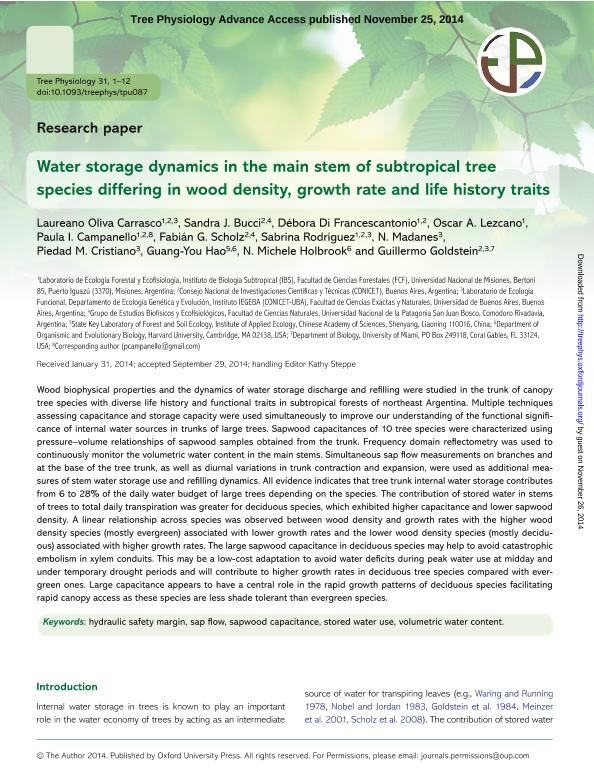Artículo
Water storage dynamics in the main stem of subtropical tree species differing in wood density, growth rate and life history traits
Oliva Carrasco, Laureano ; Bucci, Sandra Janet
; Bucci, Sandra Janet ; Di Francescantonio, Débora
; Di Francescantonio, Débora ; Lezcano, Oscar Antonio; Campanello, Paula Inés
; Lezcano, Oscar Antonio; Campanello, Paula Inés ; Scholz, Fabian Gustavo
; Scholz, Fabian Gustavo ; Rodríguez, Sabrina Andrea
; Rodríguez, Sabrina Andrea ; Madanes, N.; Cristiano, Piedad María
; Madanes, N.; Cristiano, Piedad María ; Hao, Guang You; Holbrook, N. Michele; Goldstein, Guillermo Hernan
; Hao, Guang You; Holbrook, N. Michele; Goldstein, Guillermo Hernan
 ; Bucci, Sandra Janet
; Bucci, Sandra Janet ; Di Francescantonio, Débora
; Di Francescantonio, Débora ; Lezcano, Oscar Antonio; Campanello, Paula Inés
; Lezcano, Oscar Antonio; Campanello, Paula Inés ; Scholz, Fabian Gustavo
; Scholz, Fabian Gustavo ; Rodríguez, Sabrina Andrea
; Rodríguez, Sabrina Andrea ; Madanes, N.; Cristiano, Piedad María
; Madanes, N.; Cristiano, Piedad María ; Hao, Guang You; Holbrook, N. Michele; Goldstein, Guillermo Hernan
; Hao, Guang You; Holbrook, N. Michele; Goldstein, Guillermo Hernan
Fecha de publicación:
11/2014
Editorial:
Oxford University Press
Revista:
Tree Physiology
ISSN:
1758-4469
e-ISSN:
0829-318X
Idioma:
Inglés
Tipo de recurso:
Artículo publicado
Clasificación temática:
Resumen
Wood biophysical properties and the dynamics of water storage discharge and refilling were studied in the trunk of canopy tree species with diverse life history and functional traits in subtropical forests of northeast Argentina. Multiple techniques assessing capacitance and storage capacity were used simultaneously to improve our understanding of the functional significance of internal water sources in trunks of large trees. Sapwood capacitances of 10 tree species were characterized using pressure?volume relationships of sapwood samples obtained from the trunk. Frequency domain reflectometry was used to continuously monitor the volumetric water content in the main stems. Simultaneous sap flow measurements on branches and at the base of the tree trunk, as well as diurnal variations in trunk contraction and expansion, were used as additional measures of stem water storage use and refilling dynamics. All evidence indicates that tree trunk internal water storage contributes from 6 to 28% of the daily water budget of large trees depending on the species. The contribution of stored water in stems of trees to total daily transpiration was greater for deciduous species, which exhibited higher capacitance and lower sapwood density. A linear relationship across species was observed between wood density and growth rates with the higher wood density species (mostly evergreen) associated with lower growth rates and the lower wood density species (mostly deciduous) associated with higher growth rates. The large sapwood capacitance in deciduous species may help to avoid catastrophic embolism in xylem conduits. This may be a low-cost adaptation to avoid water deficits during peak water use at midday and under temporary drought periods and will contribute to higher growth rates in deciduous tree species compared with evergreen ones. Large capacitance appears to have a central role in the rapid growth patterns of deciduous species facilitating rapid canopy access as these species are less shade tolerant than evergreen species.
Archivos asociados
Licencia
Identificadores
Colecciones
Articulos(CCT - NORDESTE)
Articulos de CTRO.CIENTIFICO TECNOL.CONICET - NORDESTE
Articulos de CTRO.CIENTIFICO TECNOL.CONICET - NORDESTE
Articulos(CCT-CENPAT)
Articulos de CTRO.CIENTIFICO TECNOL.CONICET - CENPAT
Articulos de CTRO.CIENTIFICO TECNOL.CONICET - CENPAT
Articulos(IBS)
Articulos de INSTITUTO DE BIOLOGIA SUBTROPICAL
Articulos de INSTITUTO DE BIOLOGIA SUBTROPICAL
Articulos(IEGEBA)
Articulos de INSTITUTO DE ECOLOGIA, GENETICA Y EVOLUCION DE BS. AS
Articulos de INSTITUTO DE ECOLOGIA, GENETICA Y EVOLUCION DE BS. AS
Citación
Oliva Carrasco, Laureano; Bucci, Sandra Janet; Di Francescantonio, Débora; Lezcano, Oscar Antonio; Campanello, Paula Inés; et al.; Water storage dynamics in the main stem of subtropical tree species differing in wood density, growth rate and life history traits; Oxford University Press; Tree Physiology; 35; 4; 11-2014; 354-365
Compartir
Altmétricas



